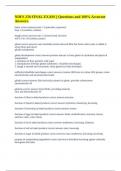NDFS 250 FINAL EXAM || Questions and 100% Accurate
Answers.
batter correct answers pour 1:1 (pancakes, popovers)
drop 1:2 (muffins, cookies)
dough correct answers soft 1:3 (yeast bread, biscuits)
stiff 1:6 to 1:8 (cookies, pastry)
gluten correct answers water insoluble protein network/film that forms when water is added to
wheat flour and mixed
gliadin and glutenin
gluten development correct answers proteins interact to form gluten via hydration and physical
manipulation
1. hydration of flour particles with water
2. manipulation develops gluten (sulfhydryl - disulfide interchange)
3. dough is smooth and viscoelastic when gluten has fully developed
sulfhydryl-disulfide interchange correct answers cysteine (SH) turn to cystine (SS) groups, create
intermolecular and intramolecular bonds
gliadin correct answers fluid and sticky protein in gluten, provides cohesiveness
intramolecular SS
glutenin correct answers form fibrils, providing elasticity
intra and intermolecular SS
function of flour in baked products correct answers structure
function of liquid in baked products correct answers hydration, dissolving, leavening
function of leavening in baked products correct answers texture
function of eggs in baked products correct answers binds, emulsification, structure, leaven,
nutritive value, color, flavor
function of fat in baked products correct answers tenderness, leavening, flakiness
function of salt in baked products correct answers taste, leavening
function of sugar in baked products correct answers taste, tenderness, browning, leavening
purpose of manipulating ingredients correct answers to distribute leavening agents uniformly
throughout the batter
,distribute fat uniformly throughout the flour
distribute liquid uniformly
factors affecting optimum manipulation correct answers volume of mix, size and shape of bowl,
effectiveness of the mixing utensil, whether strokes are vigorous or weak, timing with electric
mixer helps but can differ with mixer, beaters, and bowls
cream correct answers to work sugar crystals into fat to incorporate air
cut correct answers to progressively subdivide fat into flour
fold correct answers to gently incorporate one ingredient into another using a knife, spatula or
flexible scraper
knead correct answers to stretch, fold, and press dough gently to form and arrange strands of
gluten
whip correct answers to beat rapidly for the purpose of incorporating air
changes in batters and doughs during baking correct answers fat melts and mixture becomes
fluid, baking powder continues to form CO2, gases expand and produce leavening, proteins in
flour denature, starch gelatinizes (starch and protein set structure), water evaporates and surface
browns, odor compounds volatilize (aroma)
adjustments for baking at high temperatures correct answers reduction of leavning agent (lower
atmospheric pressure)
increased water (lower bp and > evaporation)
more flour (to increase structure to hold leavening gases)
quick bread correct answers relatively quick to mix before baking, leaven rapidly with baking
powder, baking soda, steam, or air
ex: popovers, cream puffs, muffins, biscuits, waffles, pancakes
quality attributes of traditional muffins correct answers optimum manipulation and optimum
liquid in batter creates a thin, uniform, golden brown crust; symmetrical top
light and tender
holes in crumb are round and medium sized
quality attributes of biscuits correct answers proper kneading allows for full rise
pastry ingredients correct answers flour, fat, water
function of flour in pastry correct answers physical structure for flakiness and gluten
development
, function of fat in pastry correct answers tenderness (shortens gluten development by water
proofing flour)
breaks up texture to create flakiness (separates layers of flour)
function of water in pastry correct answers steam for leavening, produce flakiness
gluten development (hydrate flour particles)
effect of type of fat on pastry correct answers lard- tender, flaky; superior in flavor
shortening- tender and flaky
oil- tender, not flaky
physical qualities of pastry correct answers tenderness due to high fat concentrations; affected by
extent of gluten development and its distribution
flakiness due to horizontal layering effect; depends on incomplete blending of fat and flour
(cutting of cold, solid fat, use of cold water and chilling of dough)
flakiness of pastry correct answers 1. water droplets heat and turn to steam, water vapor pushes
upward and outward, encountering fat barriers
2. pressure from the steam pushes against the fat layer and lifts the dough
3. steam moves horizontally along the fat barrier until it can move upward again- which shortens
the texture and also enhances flakiness
causes of too tender pastry correct answers oil instead of plastic fat, warm fat, pastry flour,
cutting fat excessively, under manipulation, too little water
causes of too tough pastry correct answers too little fat, excess flour on board, cutting fat
insufficiently, too much manipulation, too much water
conventional mixing method correct answers 1. cream sugar with solid B' fat
2. add eggs and blend with creamed fat and sugar (emulsifier)
3. portion .5 of both liquid and dry ingredients aded and stirred into creamed mass
4. repeat for second portion
purpose of creaming leaven shortened cakes correct answers work sugar crystals into solid fat,
introduces air bubbles
solid B' fat works best
muffin mixing method correct answers 1. blend eggs and milk, add with melted fat
2. sift dry ingredients together
3. stir liquid ingredients into dry ingredients
-smaller volume, coarser crumb, and quicker staling
-less time and work needed, good when eaten warm
movement of batter during baking correct answers 1. as batter hears, convection currents and
expanding gases set constituents in motion
2. internal pressure inside cake causes violent movement in batter




